Le Puy-en-Velay in Haute-Loire |
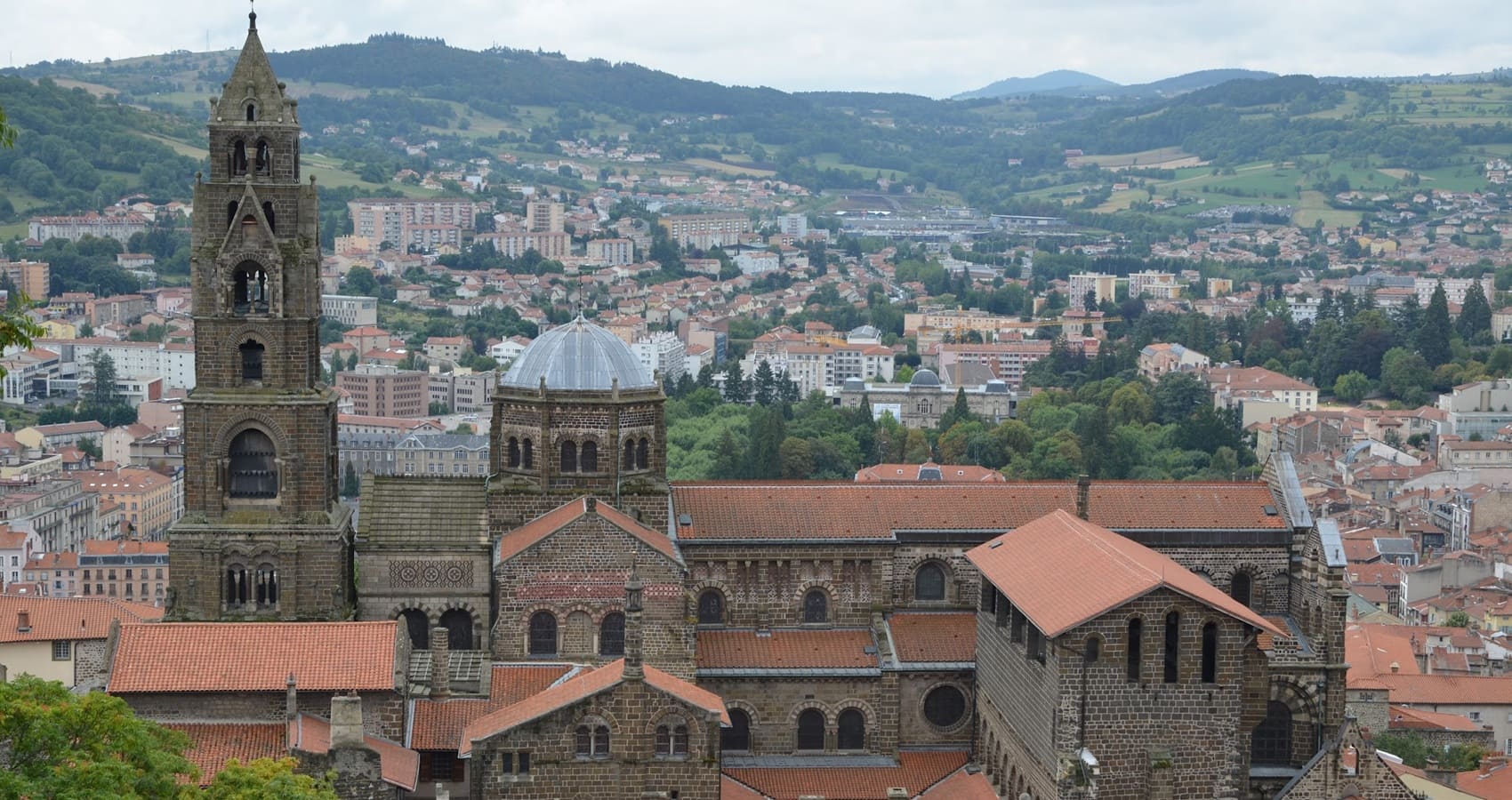
Le Puy-en-Velay in Haute-Loire |

 Le Puy-en-Velay is a city located in the Haute-Loire department, in the Auvergne-Rhône-Alpes region. It is a historic and tourist city, known for its architectural and religious heritage, as well as its importance on pilgrimage routes.Le Puy-en-Velay is famous for its Notre-Dame-du-Puy Cathedral, a Romanesque monument dating back to the 11th century, which is listed as a UNESCO World Heritage Site. The city is also known for its Saint-Michel d'Aiguilhe Chapel, a small church perched on a volcanic rock that offers breathtaking views of the city and the Loire Valley.
Le Puy-en-Velay is a city located in the Haute-Loire department, in the Auvergne-Rhône-Alpes region. It is a historic and tourist city, known for its architectural and religious heritage, as well as its importance on pilgrimage routes.Le Puy-en-Velay is famous for its Notre-Dame-du-Puy Cathedral, a Romanesque monument dating back to the 11th century, which is listed as a UNESCO World Heritage Site. The city is also known for its Saint-Michel d'Aiguilhe Chapel, a small church perched on a volcanic rock that offers breathtaking views of the city and the Loire Valley.
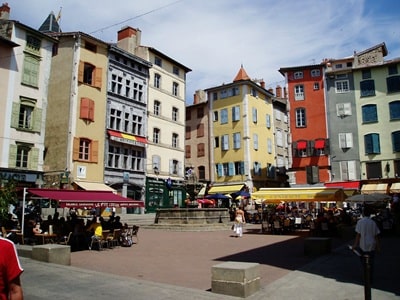 Le Puy-en-Velay is also the starting point for several pilgrimage routes, including the Camino de Santiago and the Stevenson Trail. The city hosts thousands of pilgrims each year in search of spirituality and cultural discovery.Finally, the city is also known for its production of lace, porcelain items, and green lentils from Puy, a variety of lentils grown locally and appreciated for their flavor and quality.
Le Puy-en-Velay is also the starting point for several pilgrimage routes, including the Camino de Santiago and the Stevenson Trail. The city hosts thousands of pilgrims each year in search of spirituality and cultural discovery.Finally, the city is also known for its production of lace, porcelain items, and green lentils from Puy, a variety of lentils grown locally and appreciated for their flavor and quality.
Seat of the bishops of Velay and capital of the Velay country since the 6th century (Poridum Anicience). The pilgrimage to the Black Virgin brought fame and prosperity to the city from the early Middle Ages. Le Puy-en-Velay was initially part of the duchy of Guyenne, then came under the jurisdiction of the Count-Bishops, co-lords with the King of France, and remained loyal to the Crown as well as to the Catholic faith. The lace-making industry flourished in the 16th century.
In the past, pilgrims gathered in the Place du Plot, each looking for companions to make the journey safer. From this square, in fact, several pilgrimage routes depart: Rue Pannessac towards Auvergne, Saint-Julien de Brioude or La Chaise-Dieu, Rue Saint-Jacques towards Compostela, and Rue Saint-Gilles or GR®700 Voie Régordane.
On Rue Saint-Gilles, there was a hospital of the same name known since 1227. This street opened into the rampart through the Porte de Saint Gilles, so called, writes Etienne Médicis, in the 16th century, because from this gate one goes from the said city of Le Puy-en-Velay to the ancient city of Saint Gilles down in Languedoc. At the corner of Rue Saint-Gilles and Place du Plot, there is a statue of Saint Gilles by Madeleine Déchaux, placed on November 13, 1997. On the site of the Town Hall of Vals, there was a hospital in the 12th century, then a convent of Penance, an Augustinian monastery, and finally, until fairly recently, a Jesuit novitiate.
In the Place du Breuil, at the center of the city, we notice the Crozatier fountain (famous founder 1794-1855). The city statue dominates the monument. The waterways of the department are represented in human form: the Loire, the Allier, the Borne, and the Dolaizon. The Haute-Loire Prefecture, the Court Palace, and the Theater surround the Place. By Rue Porte-Aiguière, we arrive at the Place du Martouret, which was the site of capital executions in past centuries and during the Revolution.
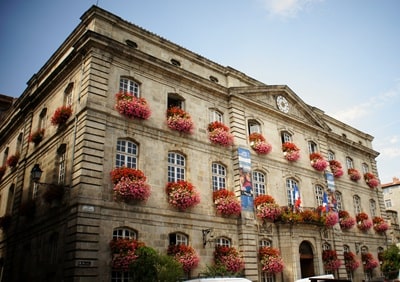 The Town Hall, rebuilt in 1766, has retained its classical façade. The interior, destroyed by a fire in 1964, has been entirely restored functionally. 100 meters away, on the East side, you can see the Church of the College, the first monument in "Jesuit" style built in France. Gilded wooden altarpieces, magnificent paintings from the 17th century (by Guy François). In Rue Saint-Pierre, above the Old Hall is the National Library (precious documents).
The Town Hall, rebuilt in 1766, has retained its classical façade. The interior, destroyed by a fire in 1964, has been entirely restored functionally. 100 meters away, on the East side, you can see the Church of the College, the first monument in "Jesuit" style built in France. Gilded wooden altarpieces, magnificent paintings from the 17th century (by Guy François). In Rue Saint-Pierre, above the Old Hall is the National Library (precious documents).
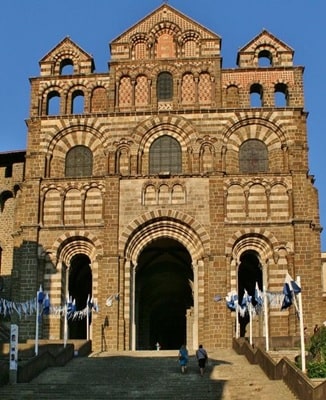 Nearby, we discover the Place du Plot with a beautiful fountain called "La Bidoire" from the 12th century. In the 16th century, wrongdoers were displayed at the pillory. (An animated market is held there on Saturday mornings). Rue Pannessac, to the northwest of the square, was the main artery of the old town. Beautiful façades of houses bearing numbers 29, 33, 42, 46, and 51 are noteworthy. In the alley of Chamarlenc, number 16 was the house "des Cornards" recalled by the macarons with inscriptions. Following the street leads to Rue Raphaël (façades 48 and 56). This street opens to the west onto Place des Tables: a beautiful fountain "du Choriste" (15th century) as well as a Renaissance façade.
Nearby, we discover the Place du Plot with a beautiful fountain called "La Bidoire" from the 12th century. In the 16th century, wrongdoers were displayed at the pillory. (An animated market is held there on Saturday mornings). Rue Pannessac, to the northwest of the square, was the main artery of the old town. Beautiful façades of houses bearing numbers 29, 33, 42, 46, and 51 are noteworthy. In the alley of Chamarlenc, number 16 was the house "des Cornards" recalled by the macarons with inscriptions. Following the street leads to Rue Raphaël (façades 48 and 56). This street opens to the west onto Place des Tables: a beautiful fountain "du Choriste" (15th century) as well as a Renaissance façade.
The Cathedral of Le Puy-en-Velay, officially known as the Cathedral of Notre-Dame de France, is a masterpiece of architecture. Listed as a UNESCO World Heritage Site, this cathedral is a major pilgrimage site and a symbol of the city.
Built on the foundations of an ancient 4th-century church, the current cathedral was erected between the 11th and 12th centuries. It was dedicated to the Virgin Mary and played a crucial role in the journey of pilgrims to Santiago de Compostela. Over the years, the cathedral has undergone several transformations and embellishments, particularly inside with the addition of chapels and decorations.
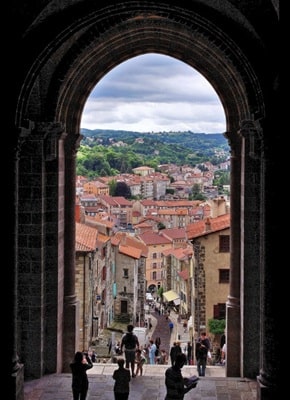 The architecture of the cathedral is a blend of Romanesque and Gothic styles. The façade is adorned with sculptures representing biblical scenes and figures of saints. The portal is particularly impressive with its richly decorated tympanums. The bell tower, octagonal in shape, rises over 80 meters high and is an iconic element of the city's skyline. Inside, you can admire ribbed vaults, side chapels, and remarkable sculptures. The stained glass windows add a colorful and warm light to the space.
The architecture of the cathedral is a blend of Romanesque and Gothic styles. The façade is adorned with sculptures representing biblical scenes and figures of saints. The portal is particularly impressive with its richly decorated tympanums. The bell tower, octagonal in shape, rises over 80 meters high and is an iconic element of the city's skyline. Inside, you can admire ribbed vaults, side chapels, and remarkable sculptures. The stained glass windows add a colorful and warm light to the space.
The Cathedral of Le Puy-en-Velay is an important pilgrimage site. Every year, thousands of pilgrims come here to pray and seek grace. The cathedral also houses relics, such as that of Saint Philomena, which attract many faithful.
From Rue des Tabies, one discovers the impressive western façade of the monument. By climbing directly (134 steps), one enters under the grand porch created by constructing four bays of the nave on pillars. (The church's floor is below the three large stained-glass windows). Two doors made of 12th-century cedar and Byzantine frescoes from the 13th century deserve attention. The Stone of Fevers is the origin of the pilgrimage since the end of the 4th century. At this point, you turn right and enter the Basilica through the southern aisle. Notice the Romano-Arabo-Byzantine architecture and the three original parts: the north transept with frescoes, the central nave's bays, and the Porch of the Fort.
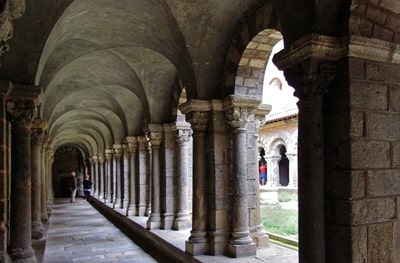 Cloister of the Cathedral
Cloister of the Cathedral
Established in the 11th and 12th centuries (classified as a historic monument), the cloister constitutes one of the most beautiful Roman ensembles in Europe. The round arches are topped by a mosaic of white, red, and black diamonds. The meeting room of the chapter of the cathedral is adorned with a Byzantine-inspired fresco: Crucifixion (13th century).
Although restored in the 19th century, the cloister presents a remarkable series of historiated capitals from the 12th century (representing the four evangelists, the race of centaurs, an abbot and an abbess disputing the crozier...). Housed in the former Hall of States of Velay, the Treasure of religious art gathers ex-votos, embroidered cloaks of the Black Virgin of Le Puy-en-Velay, a 15th-century parchment, and 17th-century sculptures by P. Vaneau.
The current Black Virgin, which replaced the one that was burned during the Revolution, is displayed on the High Altar of the 18th century. It is carried in procession every year on August 15, Feast of the Assumption. Noteworthy: the Organs, the Pulpit, the Martyrdom of Saint Andrew (sculpture by Vaneau from the 17th century). In the northern aisle: Painting of the vow of the Plague of 1630. Opposite the pulpit, beautiful Christ from the 14th century. In the southern aisle: Vow of the Consuls (1653). Frescoes of the North transept. Under the Porch of the Fort: lintel of the small door with inscriptions recalling Scutaire, the architect of the first church built around the year 430. Vaults with pierced arches (an architectural gem), fluted columns, and wonderful symbolic capitals. From the square, there is a beautiful panorama of the city and the bell tower (56m high).
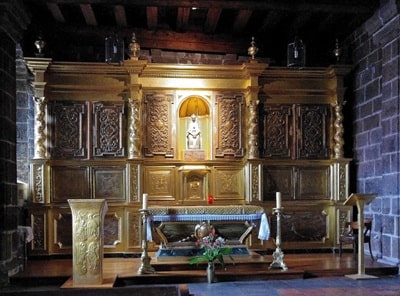 In the Sacristy: Bible of Theodulf (circa 800) Pieta (15th century) Head of Christ (15th century). Reliquaries, 17th-century sculptures, chalices, and various ornaments. Under the bell tower: Gallo-Roman sculptures and tombs of canons. The St. John Porch (12th century) adjoins the Baptistery of the same name dating from the 10th century, where baptisms took place before the Revolution. The street that opens to the north leads to Notre-Dame de France and the Cloister, which is one of the most beautiful in Europe: Fresco of the Crucifixion (13th century). Symbolic capitals, in Moorish architecture reminiscent of Cordoba. In the Building of Machicolations: Mural painting of the Liberal Arts; on the 1st floor: Treasure of religious art: numerous works of art.
In the Sacristy: Bible of Theodulf (circa 800) Pieta (15th century) Head of Christ (15th century). Reliquaries, 17th-century sculptures, chalices, and various ornaments. Under the bell tower: Gallo-Roman sculptures and tombs of canons. The St. John Porch (12th century) adjoins the Baptistery of the same name dating from the 10th century, where baptisms took place before the Revolution. The street that opens to the north leads to Notre-Dame de France and the Cloister, which is one of the most beautiful in Europe: Fresco of the Crucifixion (13th century). Symbolic capitals, in Moorish architecture reminiscent of Cordoba. In the Building of Machicolations: Mural painting of the Liberal Arts; on the 1st floor: Treasure of religious art: numerous works of art.
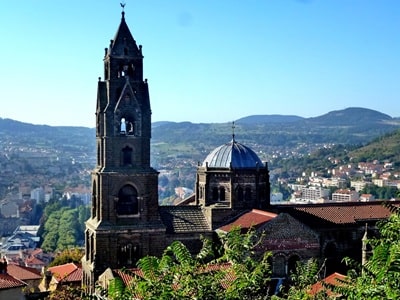 The Chapel of the Penitents from the 16th century, a true museum of local paintings. Notre-Dame de France: erected by national subscription on the platform of Rocher Corneille (757m high) in 1860. The statue alone is 16 meters high (22.70 meters with the pedestal) and weighs 110 tons of cast iron. Beautiful panorama (orientation table). To the right while descending, take the route to Saint-Michel d'Aiguilhe. You pass under the arches and the porch of the Hôtel-Dieu (12th century) and then under the Old Gouteyron Gate. Saint-Michel Rock: Chapel from the 10th century at the summit of this curious volcanic peak 80m high. The facade and bell tower are from the 12th century. Exceptional decoration on the facade. See the treasure discovered in 1955).
The Chapel of the Penitents from the 16th century, a true museum of local paintings. Notre-Dame de France: erected by national subscription on the platform of Rocher Corneille (757m high) in 1860. The statue alone is 16 meters high (22.70 meters with the pedestal) and weighs 110 tons of cast iron. Beautiful panorama (orientation table). To the right while descending, take the route to Saint-Michel d'Aiguilhe. You pass under the arches and the porch of the Hôtel-Dieu (12th century) and then under the Old Gouteyron Gate. Saint-Michel Rock: Chapel from the 10th century at the summit of this curious volcanic peak 80m high. The facade and bell tower are from the 12th century. Exceptional decoration on the facade. See the treasure discovered in 1955).
The Church of Saint Laurent (formerly of the Dominicans) houses the first tomb of Constable Duguesclin. Gothic style, 14th century. Nearby, you must visit the National Lace Conservatory (Duguesclin Street) where you can see this specialty of Puy-en-Velay being made. Also noteworthy from the Pont de la Borne, on the Route to Clermont-Ferrand, is a beautiful view of Saint-Michel d'Aiguilhe. From Boulevard Carnot, return to the city. On the left, you find the Pannessac Gate (13th century). On the right, in the square, the statue of General Lafayette. In the city center, at the back of the public garden, the Crozatier Museum (one of the richest in the province) houses beautiful collections: prehistory rooms, architecture, local arts, lace, and numerous paintings and works of art of great value.
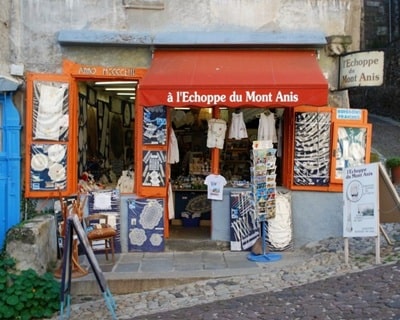 National Lace Conservatory Workshop in Puy-en-Velay
National Lace Conservatory Workshop in Puy-en-Velay
The National Lace Conservatory Workshop, established in 1976, is attached to the general administration of the National Furniture, under the Ministry of Culture.
The National Workshop is responsible for maintaining the techniques of bobbin lace: carding, lace making, finishing, and assembly. It produces high-quality artistic pieces based on contemporary models: tablecloths, napkins, handkerchiefs, doilies, sheets... which enter the collections of the National Furniture. These pieces are presented to the public during exhibitions in the Workshop or in exhibitions in France and abroad. Founded in 1974, the Bobbin Lace Teaching Center has two essential missions: maintaining the tradition and practice through teaching and preserving the lace-making heritage.
Over the years, the Center has gained international recognition and its correspondence courses, followed worldwide, make it a reference in training. Exhibition rooms allow visitors to discover a remarkable collection of old and contemporary laces, regional, national, and international. Exhibition of lace-making tools, looms, and bobbins from different countries.
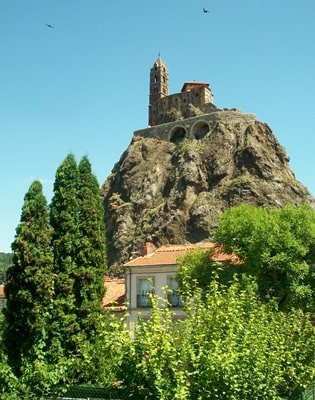 Saint-Michel d'Aiguilhe
Saint-Michel d'Aiguilhe
One of the most astonishing volcanic sites in France, the Rock (82 m high) and the Chapel of Saint-Michel d'Aiguilhe constitute an exceptional ensemble. A technical and human feat, the chapel built in 962 came into existence thanks to the bishop of Puy-en-Velay, Gothescalk, who decided to construct it upon his return from a pilgrimage to St. James of Compostela.
Discovered in 1955 during the renovation of the altar, the treasure consists of venerable relics (Christ, fabrics, ivory box) dating back to the origins of the construction. It is preserved in the chapel. Saint-Michel d'Aiguilhe is a notable example of Romanesque architecture, with its stone vaults and thick walls. The chapel was built in the 11th century, on the site of an ancient Romanesque church. It is dedicated to Archangel Michael, the patron saint of knights.
The chapel is a remarkable example of Romanesque architecture. Its plan is characterized by a single nave, a semi-circular apse, and a bulbous bell tower. The construction in volcanic stone gives it a unique appearance, harmoniously integrated into the surrounding landscape.
To reach the chapel, visitors take a path of 268 steps, offering breathtaking views of the valley and Puy-en-Velay. This journey is both a challenge and a rewarding experience. Inside, the chapel features beautiful frescoes and sculptures, reflecting the religious art of the time. The calm and serenity of the place make it a conducive space for meditation and prayer.
Located in the Henri Vinay Garden, a green haven in the heart of the city, the vast building of the Crozatier Museum (inaugurated in 1868) houses highly diverse collections whose importance and encyclopedic nature form an exceptional ensemble. Fine arts (painting, sculpture), ethnology, lace, paleontology, mineralogy, natural sciences, mechanics, local history... discovering the various rooms is a true treasure hunt. The museum has a notable collection of paintings, sculptures, and drawings, including works by 19th-century artists. It features pieces from artists such as François Marius Granet and Emmanuel Lansyer. Henri Vinay is an emblematic figure of the Velay region, known for his craftsmanship and creativity. Although not as widely recognized as some contemporary artists, his work deeply reflects the cultural and artisanal identity of Haute-Loire.
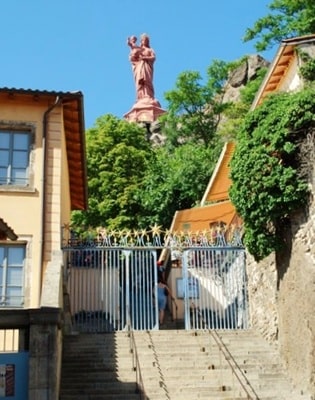 Rocher Corneille and Notre-Dame de France Statue
Rocher Corneille and Notre-Dame de France Statue
In the heart of the historic district of Puy-en-Velay, just a few minutes’ walk from the city center, the monumental statue of Notre-Dame de France represents a technical feat: erected in 1860, it was created using the metal from 213 cannons taken from the Russians during the Crimean War and donated by Napoleon III. The work of J.M. Bonnassieux, it stands 22.70 m tall and weighs 835 tons. The statue was inaugurated to mark the end of the war of 1870 and to express the faith of the inhabitants of Velay. It represents the Virgin Mary holding the child Jesus and is made of gilded copper.
The statue is a symbol of protection for the city and its inhabitants. It is often regarded as a spiritual and cultural landmark.
Each year, the site attracts thousands of pilgrims and tourists. Religious ceremonies and cultural events are organized in honor of Notre-Dame de France.
Rocher Corneille, an ancient citadel, the highest point of the Ponot basin, offers a unique panorama (orientation table) of the cathedral, the city of Puy-en-Velay, and the region with its bluish horizons. Rocher Corneille is an impressive basalt monolith that rises to nearly 750 meters in altitude. This natural site not only provides a panoramic viewpoint offering a spectacular view of Puy-en-Velay and its surroundings but is also a place steeped in history. Formed by volcanic activity, Rocher Corneille is the result of the erosion of lava flows. Its distinctive shape attracts hikers and nature enthusiasts.
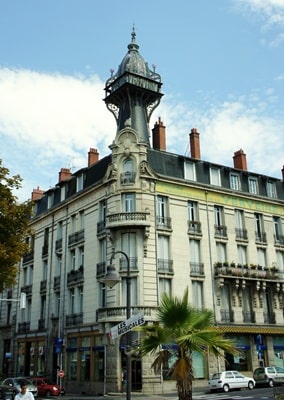 Verveine du Velay has been an emblem of Auvergne's gastronomic heritage since 1859. The Pages Distillery opens its doors wide to the public, inviting you to enter its world imbued with tradition, history, and authenticity. You will discover the secrets of making the famous liqueur, made from 32 plants, including verbena cultivated on the Velay mountains. You will meet the Master Distillers who faithfully reproduce the know-how passed down through several generations and also create other regional liqueurs and aperitifs.
Verveine du Velay has been an emblem of Auvergne's gastronomic heritage since 1859. The Pages Distillery opens its doors wide to the public, inviting you to enter its world imbued with tradition, history, and authenticity. You will discover the secrets of making the famous liqueur, made from 32 plants, including verbena cultivated on the Velay mountains. You will meet the Master Distillers who faithfully reproduce the know-how passed down through several generations and also create other regional liqueurs and aperitifs.
Verveine du Velay is an emblematic liqueur of the Auvergne-Rhône-Alpes region, specifically from Velay, a mountainous area located in the Haute-Loire department. Known for its unique taste and digestive properties, this liqueur is the result of artisanal know-how that dates back over two centuries. The production of Verveine du Velay began in the early 19th century. The monks of the Benedictine order, who utilized medicinal plants, were among the first to create infusions based on verbena, an aromatic plant known for its soothing virtues. Over the years, the recipe was refined, and the liqueur became a local specialty.
Verveine du Velay is made from hand-harvested lemon verbena leaves, combined with other aromatic plants and spices. The manufacturing process is artisanal and involves several stages, including maceration, distillation, and aging. The mixture is then sweetened and bottled. This liqueur stands out with its vibrant green color and fresh, lemony aroma. On the palate, it offers a balanced sweetness with notes of herbs and citrus. Traditionally, it is enjoyed as a digestif, but it can also be used in cocktails. Verveine du Velay is produced by several artisanal distilleries in the region. The Maison de la Verveine, a renowned distillery, has contributed to the reputation of this liqueur.
Velay is famous for its production of verbena, particularly lemon verbena. This aromatic plant, appreciated for its refreshing taste and medicinal properties, is an integral part of the local heritage. The climate of Velay is particularly suited for growing verbena. The volcanic soils rich in minerals offer an ideal environment for the growth of this plant. Verbena requires generous sunlight, which is favored by the many sunny days in the region. Verbena is typically planted in the spring, after the last frosts. Producers often choose plants from cuttings to ensure quality and flavor.
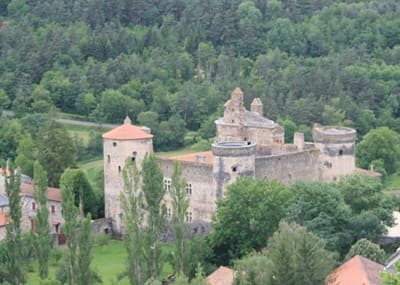 12 kilometers from Puy-en-Velay, the Château de Saint Vidal, an imposing fortress (classified as a historical monument), was the stronghold of the de la Tour de Saint-Vidal family. Originally a fortified house in the 13th century, the Saint-Vidals expanded it in the 14th and 15th centuries. Transformed and adapted for artillery in the 16th century by Antoine II de la Tour de Saint-Vidal (governor of Velay and Gévaudan), who added a keep to the three existing towers and built an outer wall. Built in the 12th century, the Château de Saint-Vidal initially served as a strategic fortress. It was the residence of the Saint-Vidal family, who played an important role in the political and military affairs of the time.
12 kilometers from Puy-en-Velay, the Château de Saint Vidal, an imposing fortress (classified as a historical monument), was the stronghold of the de la Tour de Saint-Vidal family. Originally a fortified house in the 13th century, the Saint-Vidals expanded it in the 14th and 15th centuries. Transformed and adapted for artillery in the 16th century by Antoine II de la Tour de Saint-Vidal (governor of Velay and Gévaudan), who added a keep to the three existing towers and built an outer wall. Built in the 12th century, the Château de Saint-Vidal initially served as a strategic fortress. It was the residence of the Saint-Vidal family, who played an important role in the political and military affairs of the time.
During the Hundred Years' War and the Wars of Religion, the castle served as a defensive stronghold, testifying to the tumultuous history of France. It was classified as a historical monument in 1926. The castle retains vaulted cellars and a ribbed kitchen with immense chimneys from its feudal origins. Renaissance windows, a sculpted stone portal, French ceilings, and a vaulted gallery of ribs bordering an inner courtyard are its decorative elements; numerous arrow slits, cannon ports, and machicolations are its defensive features.
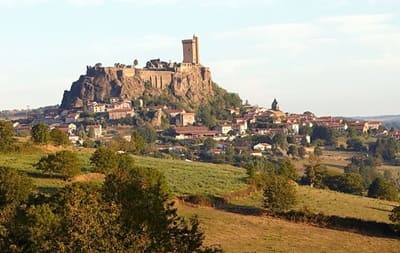 The Fortress of Polignac was founded in the 11th century by the Polignac family, a noble lineage that played a crucial role in local history. Initially built as a defensive point, it witnessed numerous conflicts, particularly during the Hundred Years' War and the Wars of Religion. A medieval residence with a walkway and unique defensive system stands on a dyke that serves as its pedestal. It is the cradle of the illustrious House of Polignac, whose tumultuous history intertwined with that of Velay and France since the early Middle Ages. From the top of the 14th-century keep (32 meters), the panorama is exceptional. A beautiful chapel, dedicated to Saint George, is located within the ramparts, adding a spiritual dimension to the site.
The Fortress of Polignac was founded in the 11th century by the Polignac family, a noble lineage that played a crucial role in local history. Initially built as a defensive point, it witnessed numerous conflicts, particularly during the Hundred Years' War and the Wars of Religion. A medieval residence with a walkway and unique defensive system stands on a dyke that serves as its pedestal. It is the cradle of the illustrious House of Polignac, whose tumultuous history intertwined with that of Velay and France since the early Middle Ages. From the top of the 14th-century keep (32 meters), the panorama is exceptional. A beautiful chapel, dedicated to Saint George, is located within the ramparts, adding a spiritual dimension to the site.
The Polignac family is a French noble lineage whose roots date back to the Middle Ages. It played a significant role in the history of France, both militarily and culturally, and is known for its contributions to politics, art, and religion. The Polignac family derives its name from the Château de Polignac, located near Puy-en-Velay in Haute-Loire. Its origins trace back to the 11th century, with ancestors engaged in military and political activities.
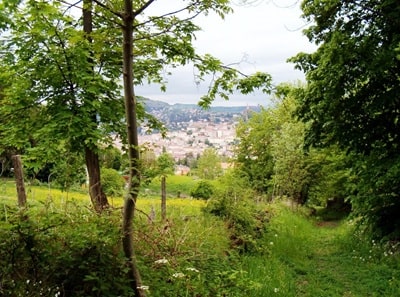 Over the centuries, the family established itself firmly in the region, acquiring lands and titles. In the Middle Ages, members of the Polignac family played an active role in political and military affairs. They were allies of the kings of France and participated in numerous military campaigns. The family was involved in the conflicts between Catholics and Protestants, supporting the Catholic cause.
Over the centuries, the family established itself firmly in the region, acquiring lands and titles. In the Middle Ages, members of the Polignac family played an active role in political and military affairs. They were allies of the kings of France and participated in numerous military campaigns. The family was involved in the conflicts between Catholics and Protestants, supporting the Catholic cause.
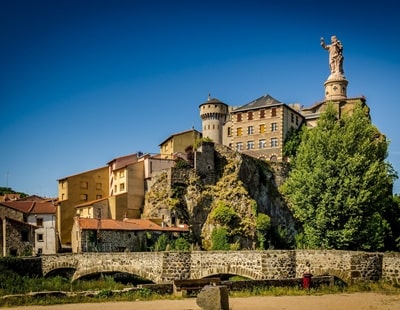 The Polignac family often arranged strategic marriages with other noble families, thereby strengthening their position. The Polignac family is also recognized for its contributions to culture and art. Several members of the lineage were patrons and supported artists, writers, and intellectuals of their time. Their commitment to the world of art and culture has left a lasting impact on the region.
The Polignac family often arranged strategic marriages with other noble families, thereby strengthening their position. The Polignac family is also recognized for its contributions to culture and art. Several members of the lineage were patrons and supported artists, writers, and intellectuals of their time. Their commitment to the world of art and culture has left a lasting impact on the region.
The Sanctuary of Saint Joseph of Good Hope, located in Espaly-Saint-Marcel, near Puy-en-Velay in Haute-Loire, is a popular place of pilgrimage and reflection. This sanctuary is dedicated to Saint Joseph, the patron saint of workers and families, and embodies a deep spirituality.
The sanctuary is surrounded by well-kept gardens and paths that allow visitors to walk while meditating. The monumental statue (22.40 m high) that dominates it was constructed of reinforced concrete. The work of Brother André Besqueut, its realization was approved by Pope Pius X. Its inauguration and blessing took place on April 11, 1910.
The sanctuary was founded in the 20th century, in response to a growing need for places of prayer and spirituality. It was built to honor Saint Joseph and his values of work, dedication, and protection. Over the years, the sanctuary has evolved and developed, attracting many pilgrims. It has become an important center of faith and spirituality in the region. The sanctuary features modern and welcoming architecture. It is surrounded by gardens and green spaces that promote meditation and tranquility. Inside, frescoes and sculptures evoke the life of Saint Joseph, creating a spiritual atmosphere conducive to prayer. The sanctuary regularly organizes masses, celebrations, and spiritual retreats. These events attract worshippers from all over the region.
Former holiday hotel with a garden along the Allier, L'Etoile Guest House is located in La Bastide-Puylaurent between Lozere, Ardeche, and the Cevennes in the mountains of Southern France. At the crossroads of GR®7, GR®70 Stevenson Path, GR®72, GR®700 Regordane Way, GR®470 Allier River springs and gorges, GRP® Cevenol, Ardechoise Mountains, Margeride. Numerous loop trails for hiking and one-day biking excursions. Ideal for a relaxing and hiking getaway.
Copyright©etoile.fr